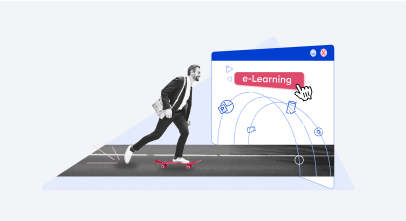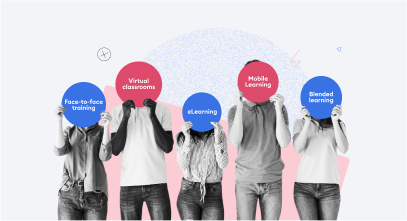Learning Experience Design: How To Make Courses Stick

Content is king. And this is definitely the case when speaking about creating eLearning courses. However, people who decide to invest in your course expect more than raw content. They’re looking for a comprehensive learning experience that will provide the easiest way for their learners to accumulate new knowledge and develop their skills.
While the content is the backbone of your course, it is the experience you create around your content that is able to make a course work. And this is where the principles of learning experience design come in.
Do you want to learn how to create stunning learning experiences? Then download this guide on LXD or continue reading the article.
What Is Learning Experience Design?
Learning Experience Design (LX design) is a way of creating human-centered and goal-oriented learning experiences that allow the learner to achieve the desired learning outcome.
“Human-centered” means that a course is created with people in mind. The developer has an understanding of adult learning and combines this knowledge with their expertise in graphic design and user interaction. “Goal-oriented” implies that a course is made for a specific purpose — that which learners should know and be able to do after completing the training.
Learning Experience Design vs. User Experience Design
The term “LX design” was created by analogy with UX (User Experience) design that is most often associated with digital design for websites and apps.
In fact, LXD and UXD have much in common — they both focus on improving the usability, accessibility, and pleasure provided in the interaction between the user and the product. Where they differ is in two important aspects — the user and the product. If a UX designer helps website or software users reach their goals when interacting with the interface, an LX designer does everything possible in order for the learner to achieve their learning outcomes when interacting with the course.
Learning Experience Design vs. Instructional Design
There is no clear distinction between LXD and ID (Instructional Design). They’re both about creating engaging and effective learning experiences. However, some eLearning experts, Connie Malamed for example, consider the term “Learning Experience Design” to be more appropriate for what is implied with these concepts.
“The term instructional feels a little dated. It focuses on materials rather than users, and may summon images of filmstrips and overhead projectors,” says the expert. With LX design, the focus shifts from instructions and materials to learners and how they perceive the training events. Connie believes that this helps instructional designers stay concentrated on pedagogy and on creating learning experiences that are valuable for people.
Elements of Learning Experience Design
There’s a significant difference, however, in the kind of experience you’re going to design. For example, if you’re going to create a food delivery app, a game, or build an online marketing course for employees, you will use different methods, approaches, and frameworks. However, the elements that should be considered during the design process are the same.
A famous User Experience Designer, Jesse James Garrett, offers his Elements of User Experience diagram, which is most relevant to digital product design. Since we discovered that the elements are the same for LXD, we have taken them as a basis and translated them into the world of learning design and development. You can view these elements as steps, which together provide a roadmap for the successful creation of an online course.
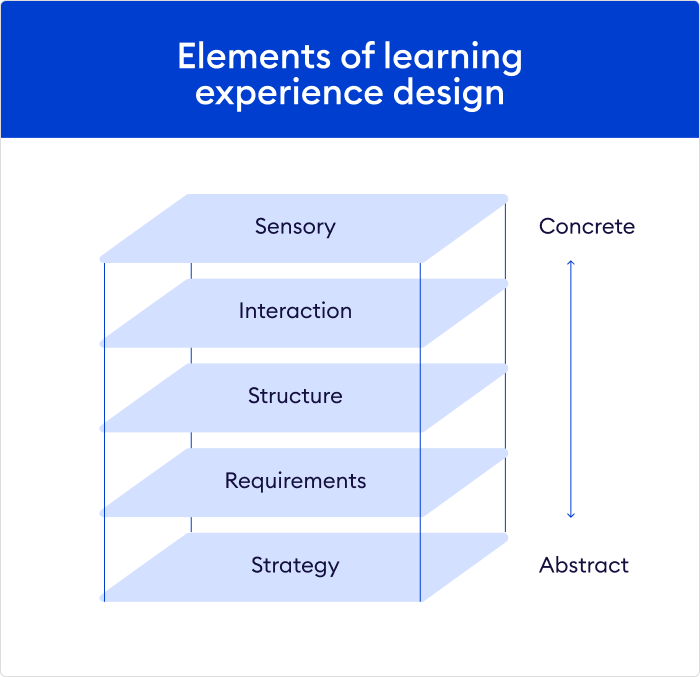
Step 1. Develop a strategy
This element is all about identifying the needs of both the organization and learners. What should the course accomplish for the business? What do learners want to gain from it?
Understanding which goals they both want to achieve will enable you to properly define the gaps between the needs of these two groups, so you can design a learning experience that is a success for both.
Step 2. Define requirements
With a clear sense of what the company intends and what learners want, you can start thinking about what is to be learned, how the training process will proceed, what format the learning project will take, and what type of activities it will include.
For example, if your goal is to eliminate injuries in the workplace, you might want to create a safety training course for your employees. At this stage, you would decide that it will be a slide-based microlearning course about employee behaviors when working with electrical installations. To make sure your workers understand the information being covered, you might want to add a quiz at the end of the course.
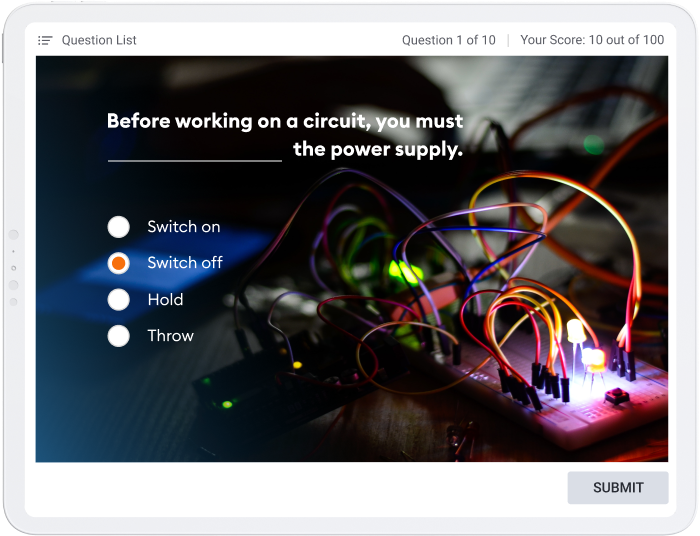
A slide from the quiz created with iSpring Suite
Step 3. Determine a structure
Now that you know what your course will be about, it’s time to map it out. You need to break the broad topic down into several narrow topics (training modules) and arrange them properly so that they flow from one to the next smoothly and provide constructive custom eLearning.
Step 4. Decide on the interaction
This element is about interacting with the course — precisely what learners will be seeing, hearing, and doing. Here, you need to think about which learning activities to use to deliver the best learning experience.
For example, you might want to add a warm welcome video from the CEO to the very beginning of your onboarding course, add slides with case studies and branching scenarios to your sales course, or transform a text section with popular questions into an engaging FAQ interaction that is perfectly suited for a mobile learning experience:
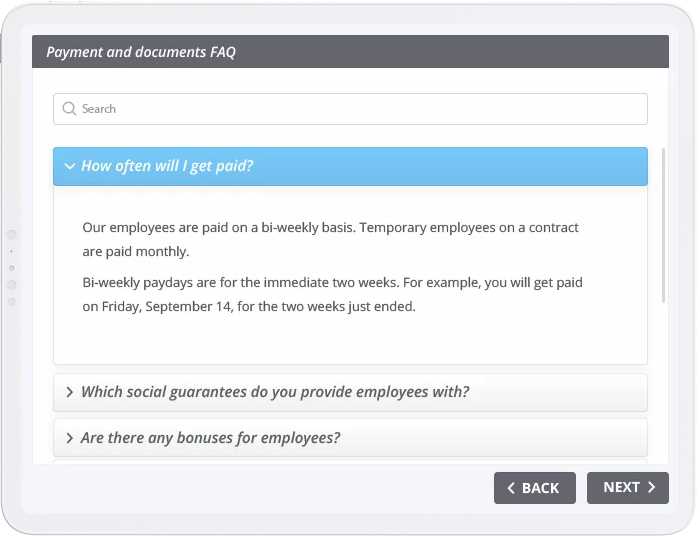
A slide from the interaction “Documents and payment FAQ” created with iSpring Suite
Step 5. Think of sensory experiences
The experience you create needs to both cater to your learners’ senses and resonate with your company’s brand. At this stage, your task is to create a learning experience that is both beautiful and functional. It’s about the tone of your writing and the visual design of your course, which should represent your organization’s branding and communicate the right mood.
8 Principles of Learning Experience Design

Ann Vasyutinskaya, an LX Designer at iSpring
Great learning experiences don’t just provide learning – they help the learners understand the information easily and retain it longer. In this section, Ann Vasyutinskaya, a Learning Experience Designer at iSpring, will share 8 principles of LXD following which you will make your courses more engaging and effective.
1. Sell the “why” on the first slide
Adult learners learn more effectively when they understand the practical use of educational content.
They should have a clear answer to “what’s in it for me?” If a learner doesn’t understand how a course will benefit them from the first moment, they will hardly be interested in continuing to view it. For example, the role of a sales rep is often high stress, and that’s why they’ll be happier to take a course about how to deal with difficult customers rather than exploring “The fundamentals of selling.”
How to apply this to a course: To engage employees, explain the benefits of the course right on the first slide. For example, include the key benefit in the title. The course topic should be related to tasks and issues an employee has to address daily.
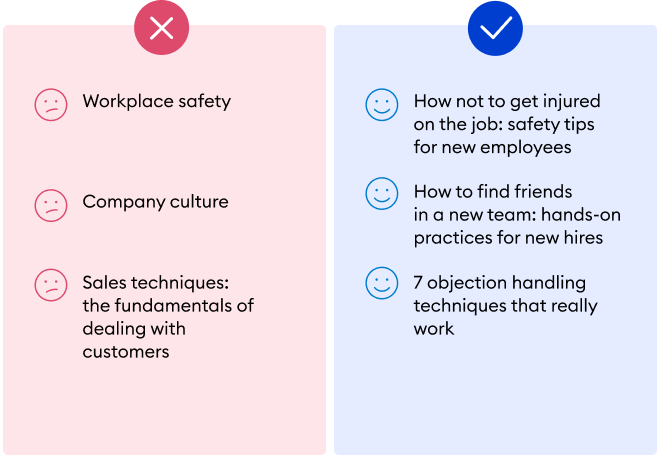
If you want your employees to be engaged in learning, you need to make the course title intriguing and as descriptive as possible.
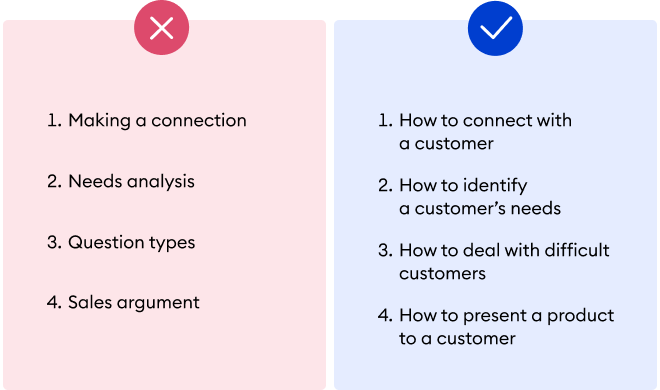
Another way to increase employees’ engagement is to write the course contents properly. Examples of course titles on the left don’t translate the course’s value, while the picture on the right explains what a learner will be able to do after they complete a course.
2. Move from simple to complex — Bloom’s taxonomy
In 1956, Benjamin Bloom, an American educational psychologist, developed a taxonomy of educational objectives. According to his learning theory, people acquire knowledge sequentially. This process consists of 6 levels:
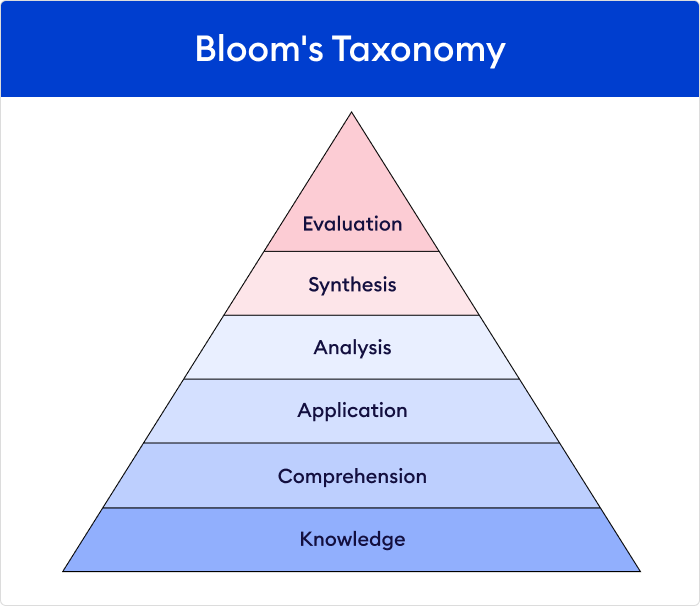
Each level relies on the previous one: if you don’t remember and understand the information, you can’t put it into practice. For example, if an employee doesn’t know the features of a new car, they won’t be able to present them to the client.
How to apply this to a course: To teach employees something new, proceed from simple to complex. First, immerse them in the topic and explain how it can benefit them. Then, tell them how it works and where it can be applied.
You can also leverage Bloom’s Taxonomy to provide effective assessments. Learn how in this article on building online quizzes.
3. Split a huge text into smaller chunks — Hick’s law
In 1952, British and American psychologists William Hick and Ray Hyman conducted an experiment to find out how long it takes for a person to make a choice. Read the full study.
The experiment involved 10 lamps with corresponding Morse code keys. The lamps would light at random, every five seconds. The participant’s task was to press the correct key for the lighting of a particular lamp.
The experiment showed that the more options a person has, the harder it is for them to remember information and make a decision.
How to apply this to a course: It is difficult for a person to remember a large amount of data in one sitting. So, don’t put too much text on a slide, but break it into several slides. Chunking helps to reduce the cognitive load and make it easier to remember the information.
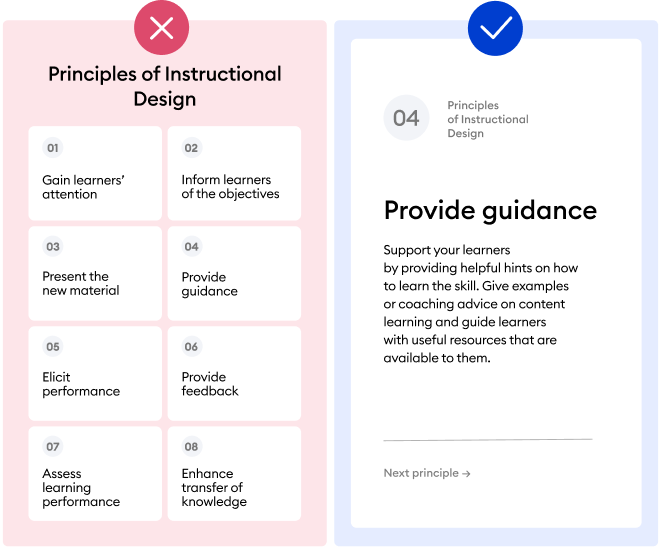
In the picture on the left, there are eight information blocks that are new for an employee, and it’s difficult to remember them all. To make it easier for your learners to memorize them, place a single principle on a separate slide.
4. Use familiar design patterns — Jakob’s Law
Jakob’s Law states: “Users spend most of their time on other sites. This means that users prefer your site to work the same way as all the other sites they already know.”
How to apply this to a course: Make sure that your course works as the learners expect it to. Use familiar icons and buttons that don’t require any explanation. For example, we are used to closing the window by clicking on the cross. If you put a triangle instead of a cross, chances are your learners will feel confused.
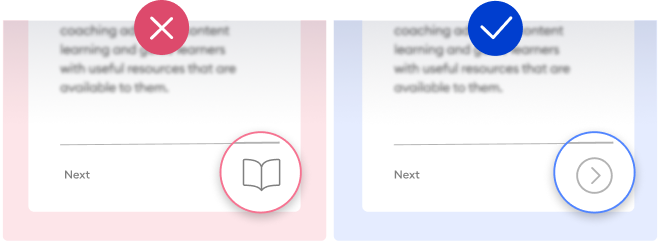
By clicking these buttons, a user is supposed to go to the next slide. However, the book button will confuse a learner, as it usually implies that something may be flipped through like the pages of a book. So, it’s better to use the familiar arrow button.
5. Place important information at the top and at the end — The sequential positioning effect
This principle is based on the discovery made by the German psychologist Hermann Ebbinghaus. According to his research, a learner remembers information better if it is structured as a list. Moreover, the first and last items on the list are remembered more accurately than those in the middle of the list.
How to apply this to a course: If you are creating lists in your course, place the most important information at the beginning and at the end. This will help your employees retain it longer.
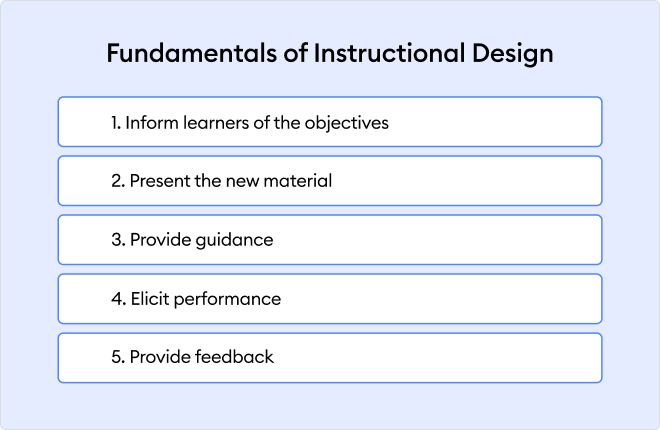
Test yourself: read all the principles, close your eyes and try to remember all of them. Which ones did you miss? Where are these principles located on the slide? If Ebbinghaus was right, chances are they’re in the center.
6. Direct attention by setting accents — The Von Restorff effect
When presented with several homogeneous objects, a person will pay attention to those that differ. This is the main idea of the isolation effect discovered by the German psychiatrist and pediatrician Hedwig Restorff in 1933. He conducted an experiment in which participants were given a list of generally homogeneous words to remember and one very distinctive word. As a result, people were more likely to remember the distinctive word.
How to apply this to a course: To draw attention to significant details, set accents. For example, in the homogeneous text, put an important term in bold, so your learners will see it immediately.
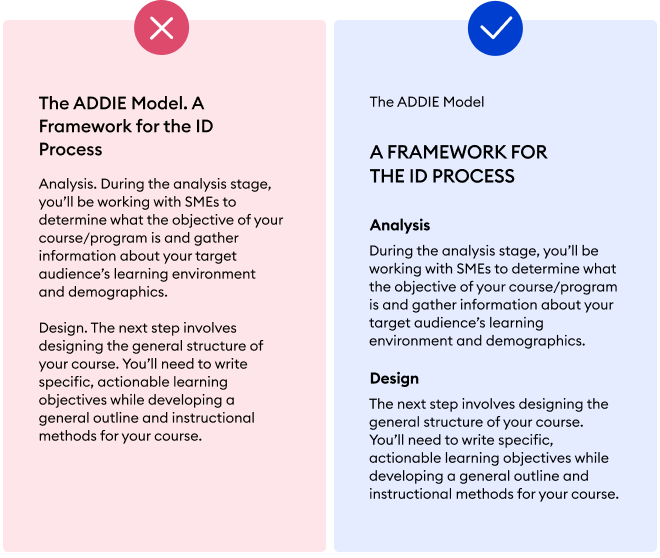
In the slide on the left, the text looks homogeneous, while the slide on the right has accents. Oversized headings and bold text made the information much easier to perceive.
7. Show the connection between elements through proximity
This principle comes from Gestalt principles of visual perception. It states that things that are close together tend to be perceived as a unified group and appear to be related.
How to apply this to a course: If blocks of information are related to each other, put them side by side.
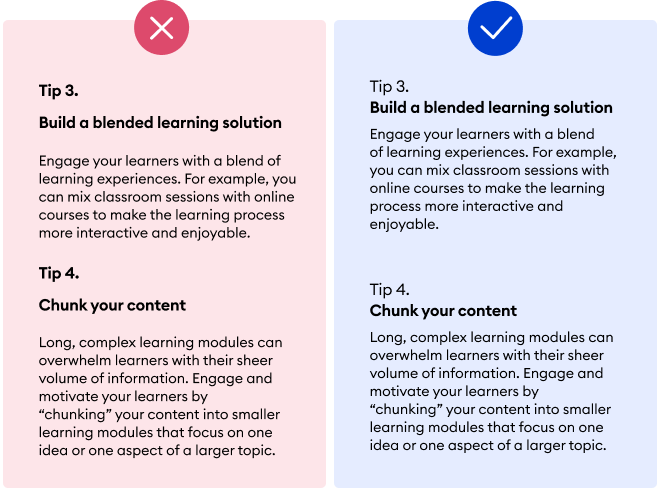
In the image on the left, the subheading and the paragraph are all spaced far apart and there’s no connection between them. In the image on the right, subheadings and paragraphs are grouped together, so it’s clear which things are related.
8. Avoid unnecessary elements — Miller’s Law
In 1956, the American psychologist George Miller found out how many items people can store in their short-term memory. To do this, the scientist performed an experiment: the participants were given a list of digits, letters, and words and had to remember as many of them as possible. It turned out that a person is able to remember from 5 to 9 elements on average.
How to apply this to a course: The text on the slide should be concise and limited to between 5 and 7 items. For example, it may include a brief idea and 4-5 supporting arguments that prove it. This will optimize the cognitive load, which means that learners will be able to remember the information better.
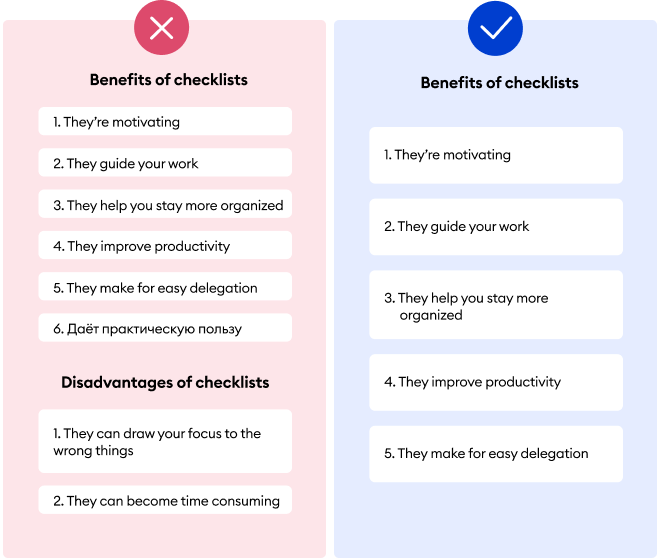
In the picture on the left, there are two different sections with many points that are difficult to remember. To make things easier for learners, split the slide into two parts — one with benefits and another one with disadvantages
Wrap-up and Further Reading
Learning experience design is a broad topic, but we hope the guidelines provided above will help you make your eLearning courses a little better and improve your corporate training outcomes. If designing for online learning is a significant part of your job, here are several blogs you might find useful:
- Instructional Design: The Art of eLearning Architecture
- How to Become an Instructional Designer: A Comprehensive Guide
- The 17 Best Books on Instructional Design: Classics and Hidden Gems
- The 50+ Best Instructional Design Software Tools and Resources in 2022
- The Top 15 Instructional Design Certificate Programs and Courses
- How to Create an Instructional Design Portfolio that Makes You Shine
If you want to create compelling courses fast, with no IT skills required, take advantage of the latest technologies in the eLearning industry. Get started with a free 14-day trial of the iSpring Suite authoring toolkit. It comes with ready-made layouts and presets that will make your learning design process even easier.








